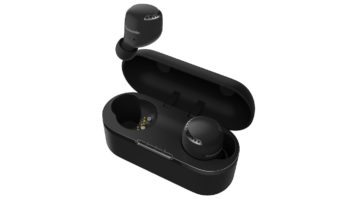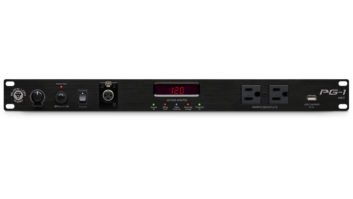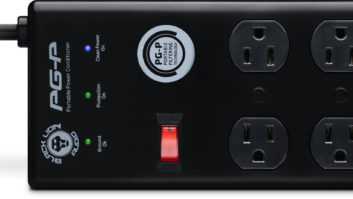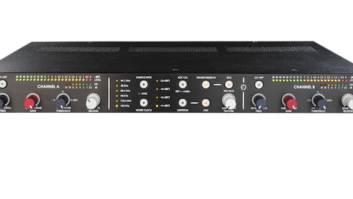8-CHANNEL A/D CONVERTER AND MIC PREAMPNow that high-resolution digital audio workstations and modular digital multitrack recorders have arrived, issues of adequate wordlength and sampling frequency are largely being resolved, at least from a data storage perspective. But the front ends of these devices, which contain analog circuitry, A/D converters and word clock read/write systems, often fail to deliver the full potential of high-resolution recording. As a result, several manufacturers have developed 8-channel A/D converters that serve as an alternative to the stock circuitry found on MDMs/DAWs. Although the cost of these outboard converter sets have historically exceeded that of the recorders they serve, prices are finally coming down.
At a list price of $2,495, the Panasonic WZ-AD96M 8-channel A/D converter and mic preamp offers a high-quality yet cost-effective front end for high-resolution digital recording systems. The 1U, rackmountable unit’s eight wide-ranging inputs accept mic or line level signals, and its 24-bit, 128-times oversampling converters output 24-, 20- or 16-bit digital audio at 44.1, 48, 88.2 or 96 kHz sampling frequencies.
THE RIGHT CONNECTIONSAll I/O connections are on the rear panel. Analog inputs for the WZ-AD96M are provided via eight female, balanced, locking XLR connectors. AES/EBU digital outputs are provided on four male XLRs. These can transmit either eight channels of high-speed, Single-Wire AES/EBU data or four channels of Dual-Wire AES/EBU data (more on this later). An ADAT lightpipe output is also provided for 8-channel output, and an optional TDIF card can be added for $395. Word clock in and through connections are provided on 75-ohm BNCs; moving two jumpers inside the unit’s chassis converts the word clock thru to word clock out, sending the internal clock signal to the connected device. Also on the rear panel are an IEC receptacle for the detachable AC cord, a grounding screw to eliminate ground loop hum and eight DIP switches.
The first DIP switch selects High-Speed, Single-Wire or Dual-Wire AES/EBU output mode. There are a number of high-resolution audio devices on the market that support one or the other, but not both modes of transmission. The WZ-AD96M will interface with either type of equipment.
In High-Speed, Single-Wire mode, the balanced XLR accommodates two channels of AES/EBU-format data on one wire. In Dual-Wire mode, only one channel is sent per XLR. An optional output card, the WZ-AESAD ($395), provides eight-channel 24/96 audio output in the Dual-Wire AES/EBU format via a D-sub connector. The owner’s manual provides a pin out diagram for making your own cables, or you can buy the Panasonic 96DB-XLRM, a three-meter breakout cable that fans out a DB-25 connector to eight XLRs.
Another DIP switch works only if you’ve changed the WZ-AD96M’s word clock thru to word clock out via the two internal jumpers. In that case, this DIP switch makes the word clock output follow either the sampling frequency set on the unit’s front panel or the AES output rate. This can be useful because some recorders require 48kHz word clock (which they double internally) to record 96kHz audio. Other DIP switches allow you to customize the response of the WZ-AD96M’s front panel meters, which we’ll discuss shortly.
FRONT PANEL CONTROLSEach of the WZ-AD96M’s eight mic preamps has a continuously variable gain pot and a 48V phantom power on/off button with its own status LED. Maximum gain at the pot’s full clockwise position is 64 dB. Full counter-clockwise position yields unity gain.
Maximum input level is +24 dBu. Although that may be a tad low for some line-level mastering applications, I suspect most users will buy this unit for tracking, given the included micpre’s. On the subject of tracking, the unit’s main ergonomic drawback is the lack of inserts or direct outs after the micpre’s. These would be useful for patching in dynamics processors or alternative A/D converters, but were obviously omitted to keep the price down.
A single, tri-color LED indicates signal/reference/peak digital meter levels to 0.05dB accuracy. The LED lights green when signal level is present but lower than the reference level. Previously mentioned DIP switches adjust the reference level – indicated by an amber LED – between -14 and -20 dBFS in 2dB increments. Other DIP switches adjust the peak detection level (which lights a red LED) to 0.0 dBFS or -0.5 dBFS or in 1dB increments from -1.0 to -6.0 dBFS.
Although the 0.0dBFS setting will alert you to clipping, the WZ-AD96M does not retain digital “overs” nor offer peak hold metering. So, there’s no way to set up the unit to simultaneously alert you to peak levels approaching clipping and digital overs. You must set it up to do one or the other. However, this is not really an issue if your recorder’s metering is comprehensive and in plain sight.
The unit’s reference level is also indicated by a separate, static display on the front panel. This is a nice touch because it allows you to see at a glance how your levels relate to other gear without having to check calibration levels with an oscillator. It’s important to realize, however, that the reference level adjustment affects only the metering and does not affect the front end’s gain structure in any way.
NORMAL AND SHIFT MODESThree other buttons on the front panel have different functions, depending on whether the unit is in Normal mode or Shift mode. In Normal mode, these buttons select the desired sampling frequency and wordlength of the digital audio output, plus whether the word clock is to be derived from the internal crystal or an external source. (An error LED alerts you to loss of sync or absence of signal.) When 16- or 20-bit wordlengths are chosen, proprietary dither is applied internally to the signals. The WZ-AD96M can lock to external word clock at sampling frequencies from 44.1 to 96 kHz, +/- 6%.
The WZ-AD96M’s shift mode allows you to route the unit’s input signals to both the stock digital outputs and the optional WZ-AESAD output card in Dual-Wire AES/EBU mode. It’s worth noting that the owner’s manual is quite confusing on this subject and leaves a number of questions unanswered. Vague references are also made regarding a 24-bit/96kHz ADAT lightpipe mode, but details as to how the data is allocated to each track and later reassembled – not to mention what devices can currently use such a format – were unavailable from Panasonic. A large Power button, with associated LED completes the front panel controls.
THE ACID TESTImpressed by the WZ-AD96M’s -128dB equivalent input noise spec, ruler-flat frequency response and dynamic range of 117 dB (A-weighted), I was eager to set up some A/B listening tests. My first recordings were of a flat-picked acoustic guitar with brand-spankin’-new strings, using DPA 4011 mics in a spaced pair configuration. I made alternate recordings with matching gain structures to an Alesis MasterLink disk recorder, first using the WZ-AD96M and then using a Millennia Media HV-3 dual-channel mic preamp and Apogee Rosetta A/D converter. Playback was through the MasterLink’s excellent D/A converters.
The HV-3/Rosetta combination offered noticeably superior transient response to the WZ-AD96M. The Panasonic unit’s transient response was quite good, but not great. However, the WZ-AD96M’s timbre was fuller in the mids than the Millennia/Apogee combo, which sounded a little thin by comparison. I decided that this was not a demonstration of superior depth, but merely a timbral difference that equalization could probably neutralize. To its credit, the WZ-AD96M’s stereo spread was equally as wide as the HV-3/Rosetta combo, a reflection of its excellent 114dB crosstalk spec.
Both sets of mic preamps (Millennia and Panasonic) were cranked to the max for this test in order to get full-scale recordings (and the Rosetta was calibrated to make up the difference in maximum available gain between the different preamps). At these admittedly extreme settings, the HV-3/Rosetta combo was noticeably quieter during program fades compared to the WZ-AD96M, which nevertheless performed well.
Next up were male vocals, recorded through the same mic preamps and converters but using a Lawson L47MP tube condenser microphone placed seven inches away from the performer. Here, the HV3/Rosetta combination offered a little more depth, aided perhaps by the extra degree of nuance and detail produced by superior transient responses. The difference sounded as if the performer had moved a few inches closer to the mic (without the added bass proximity effect) for the HV3/Rosetta recording, even though distances to the mic were stringently maintained.
CONCLUSIONSWhen considering the above A/B tests, it’s important to bear in mind that only two channels of Millennia Media HV-3 mic preamps and Apogee Rosetta converters cost more than the eight-channel WZ-AD96M. Considering its rock-bottom price, the WZ-AD96M is an excellent performer.
If you demand the highest-quality signal path possible, you’ll still have to dole out the big bucks to get it. For those on a tight budget looking for a modestly priced rack of mic pre’s and high-resolution A/D converters, the Panasonic WZ-AD96M is definitely worth a listen.







